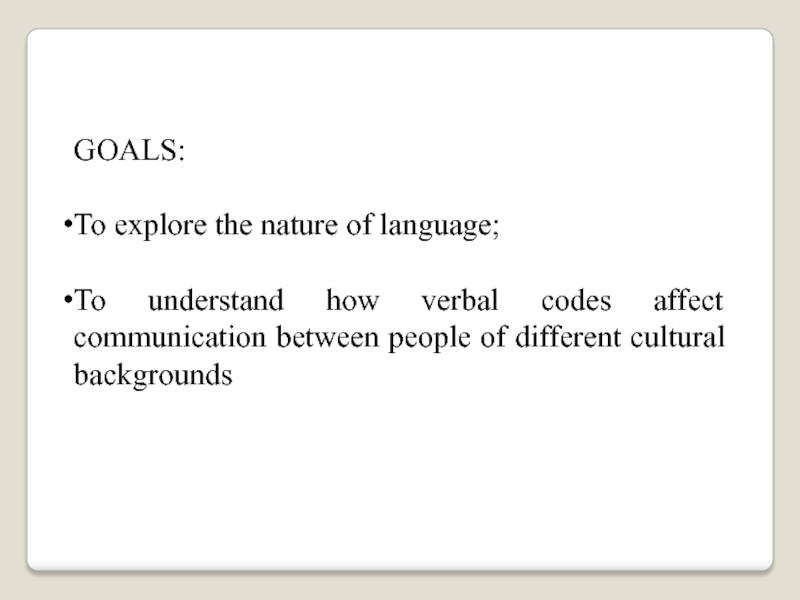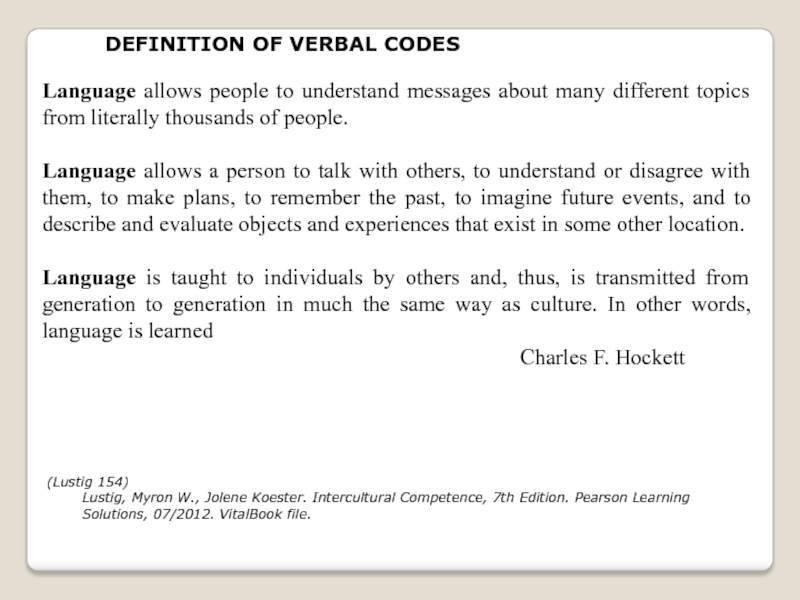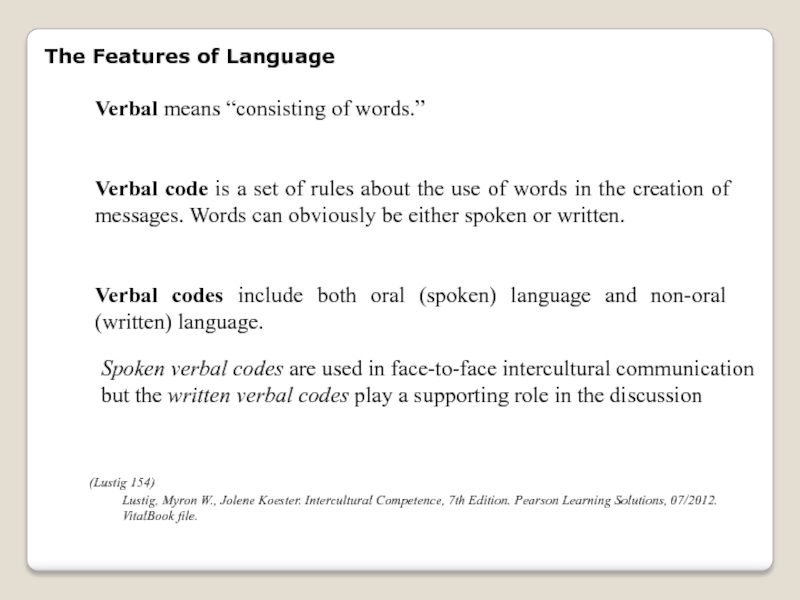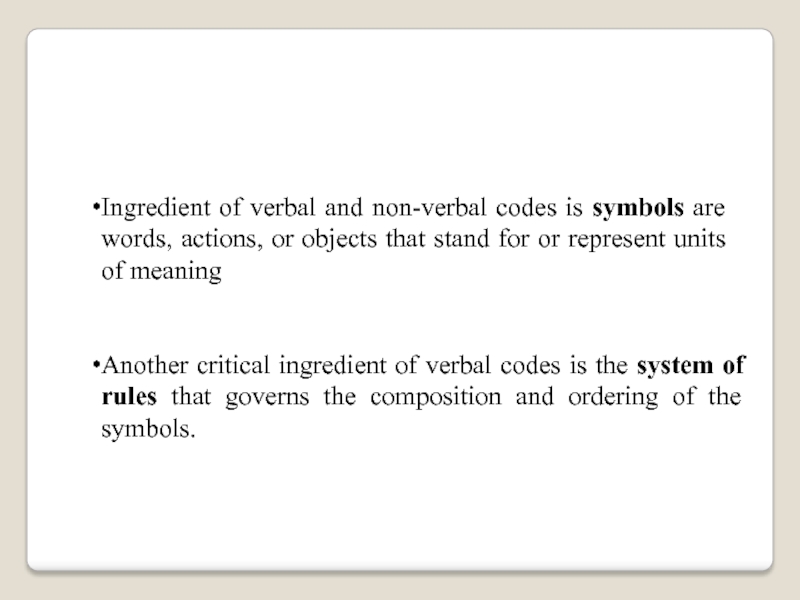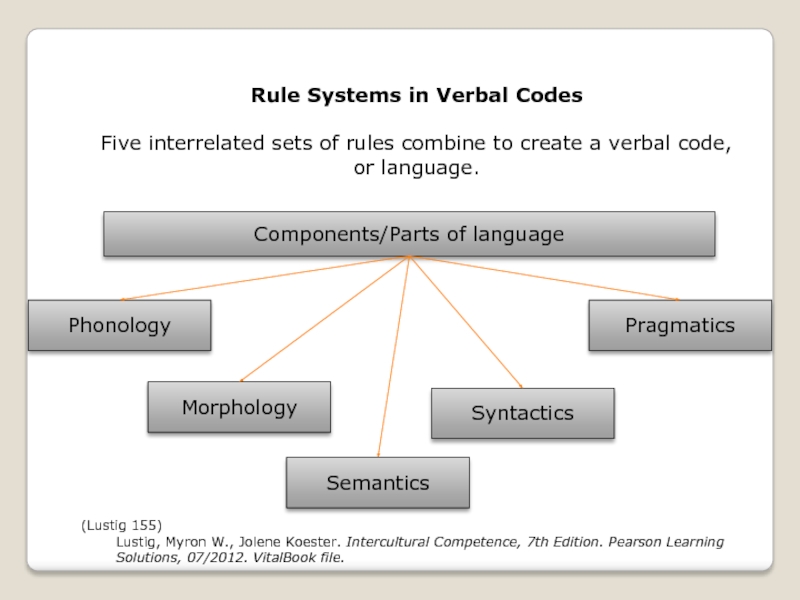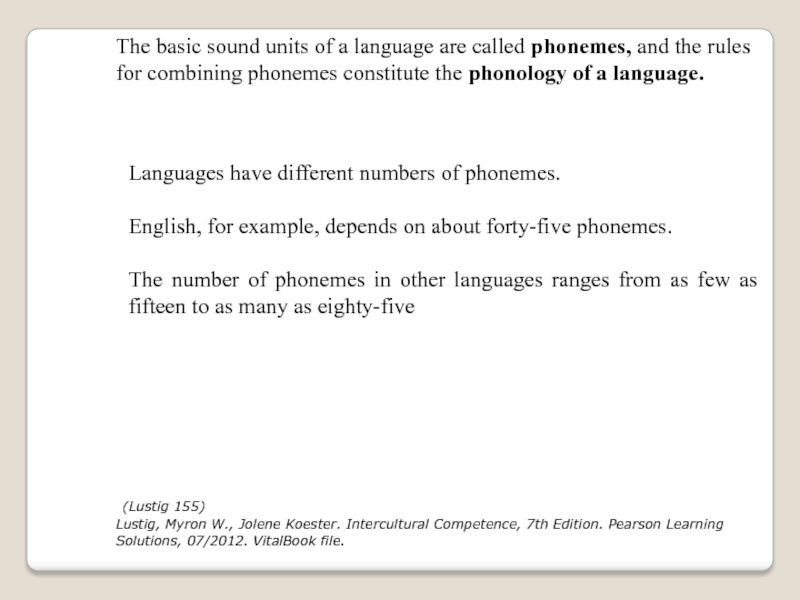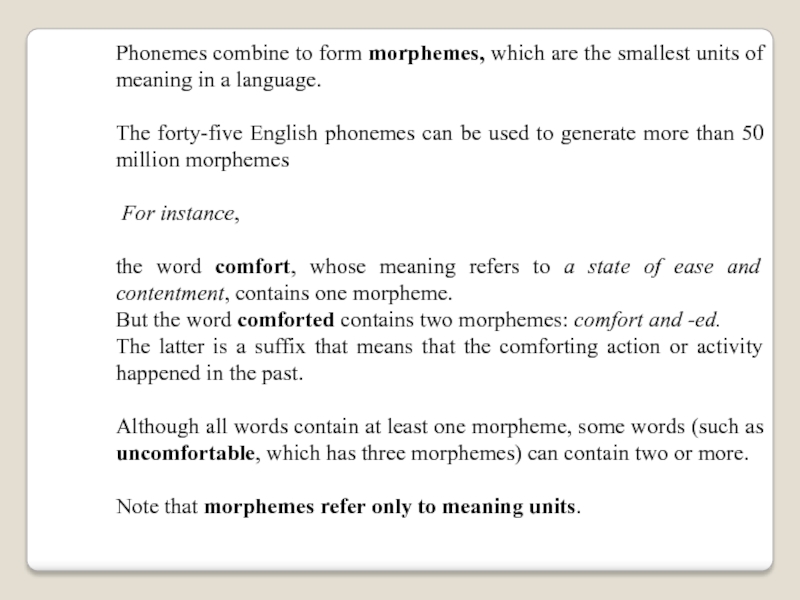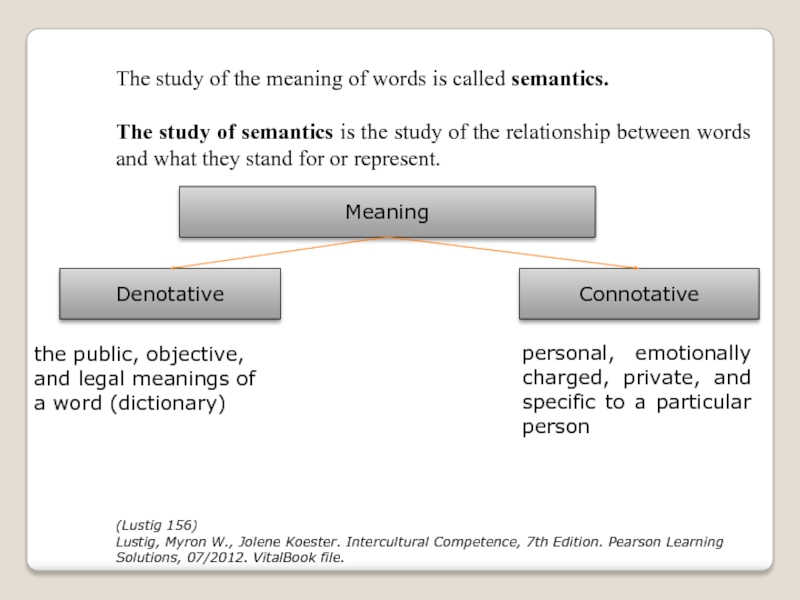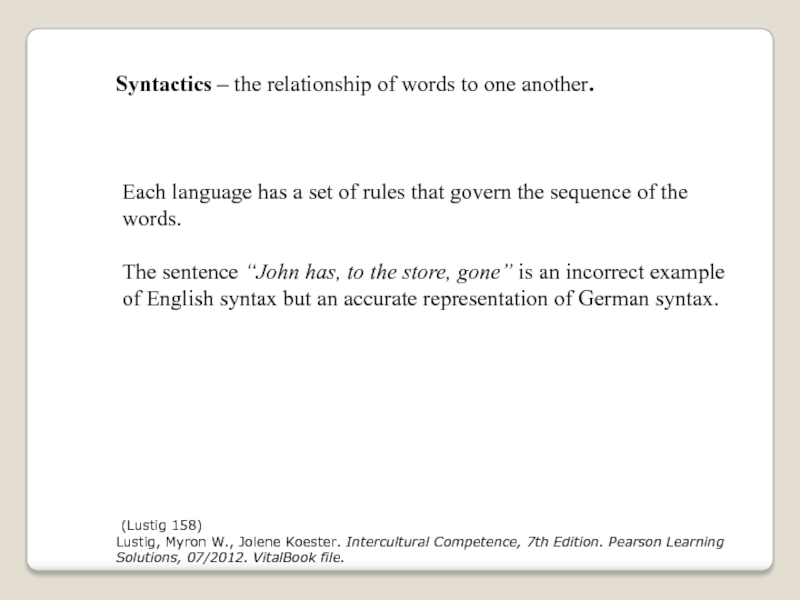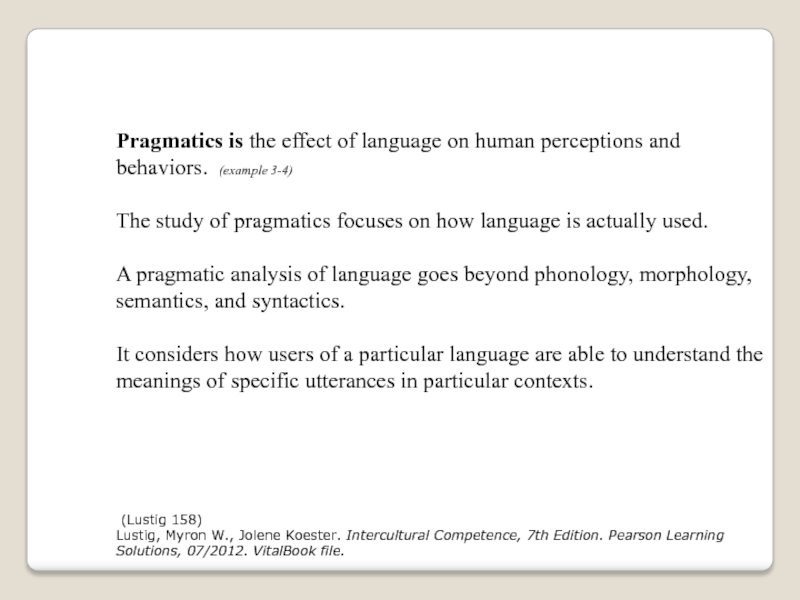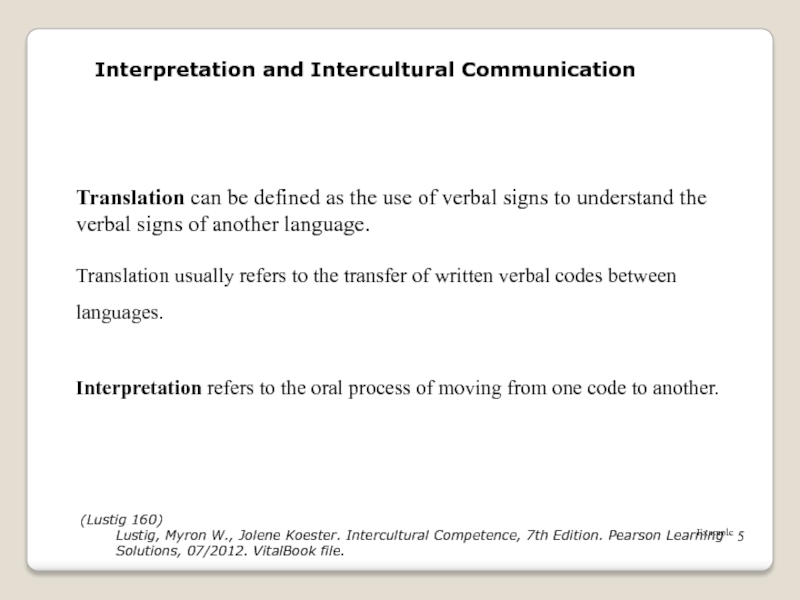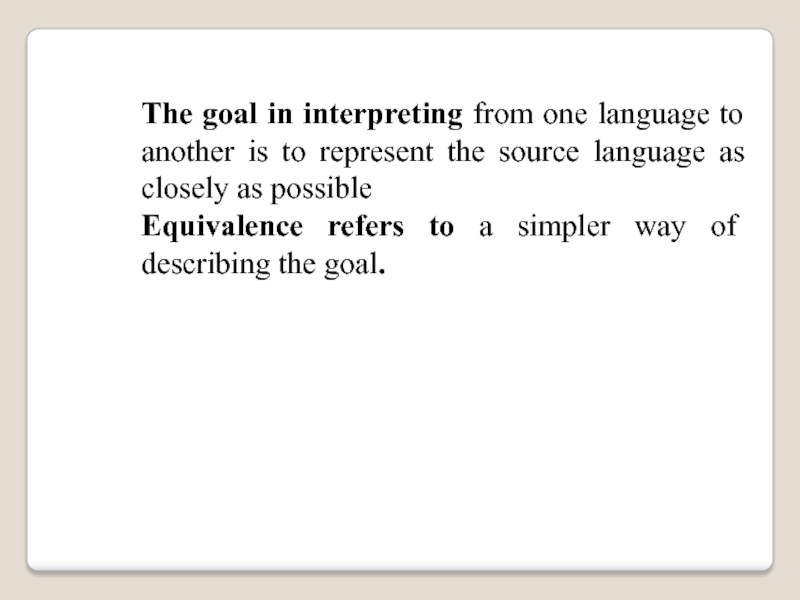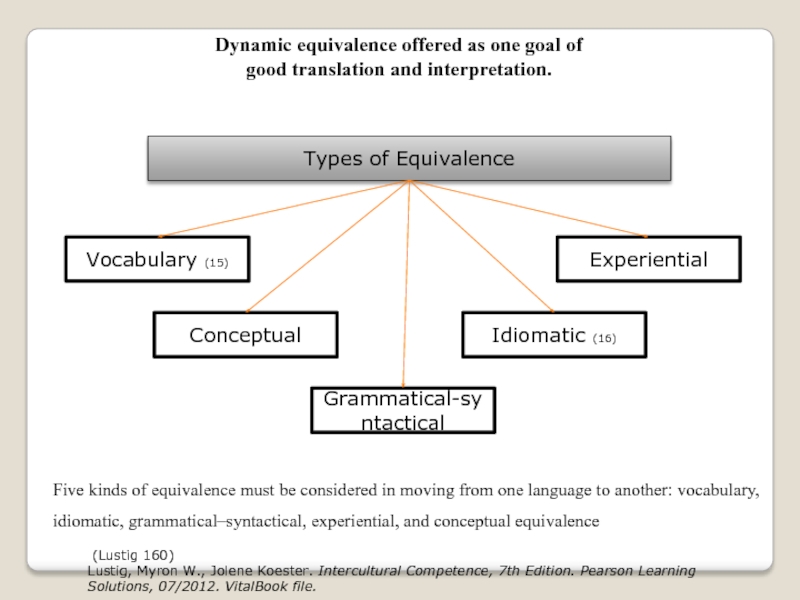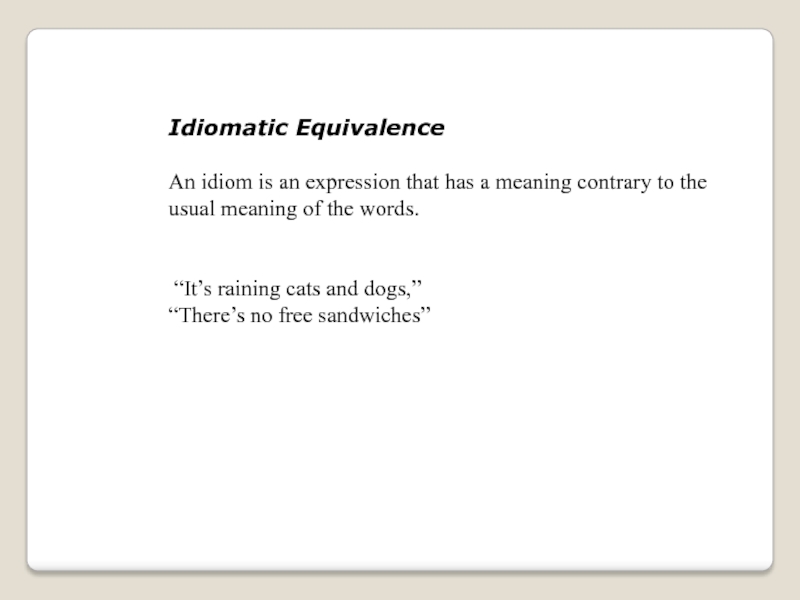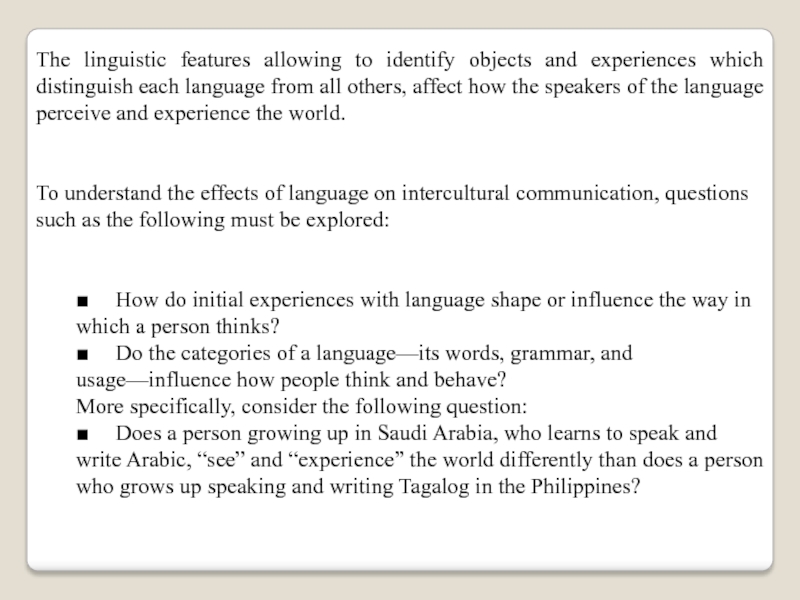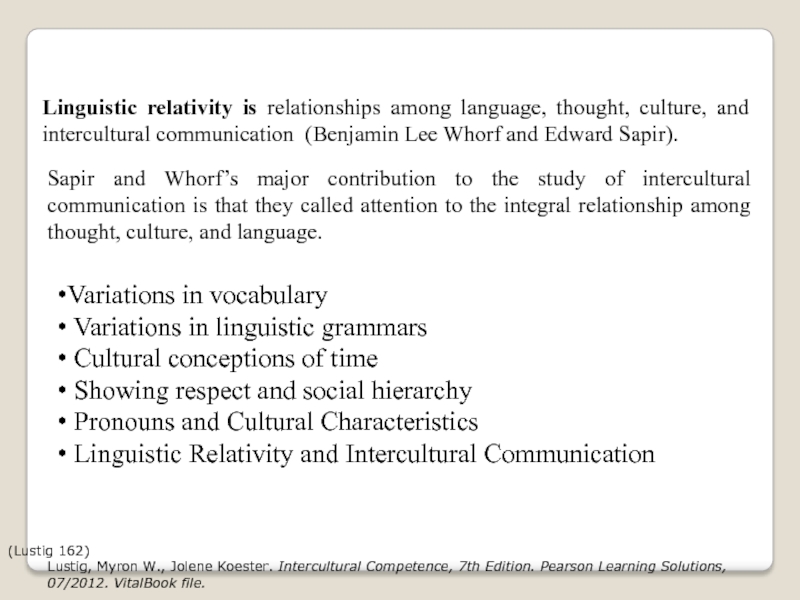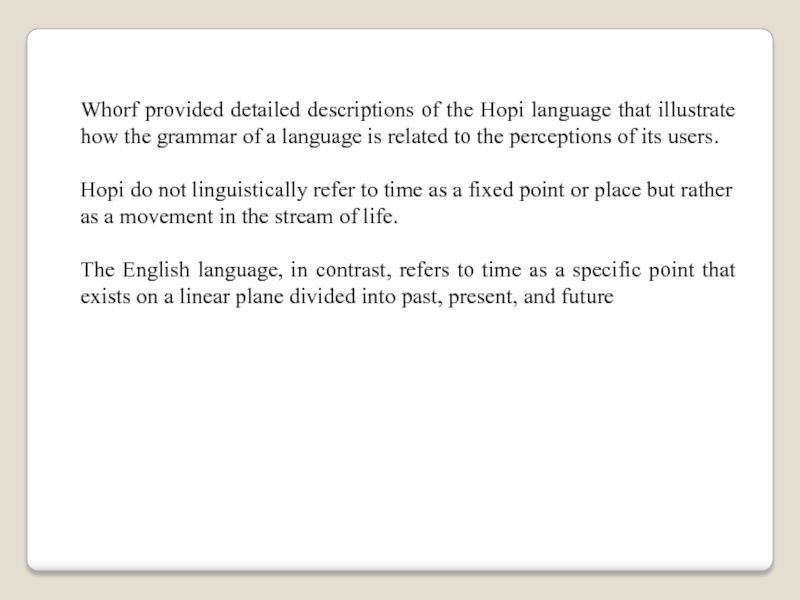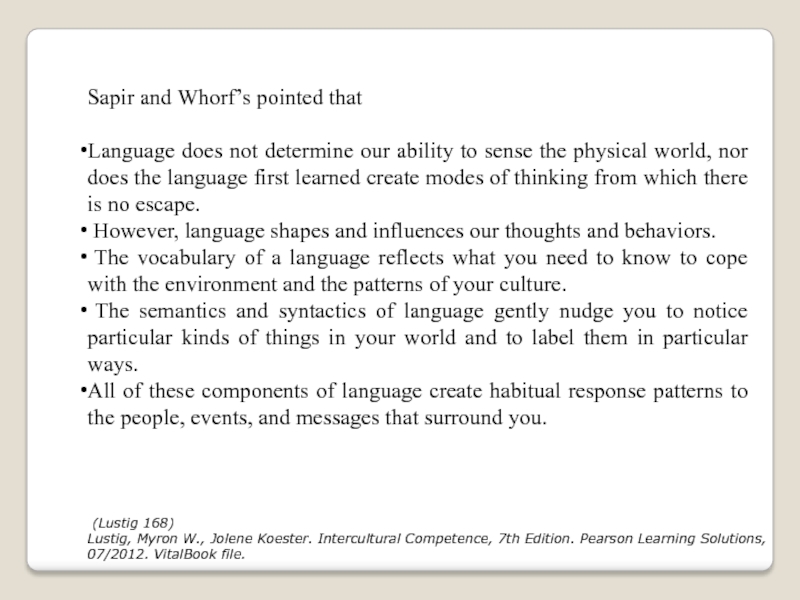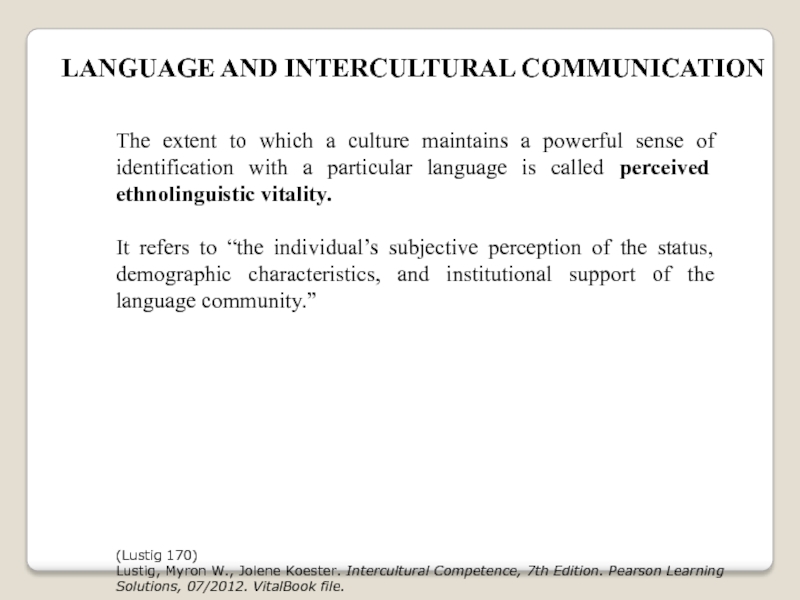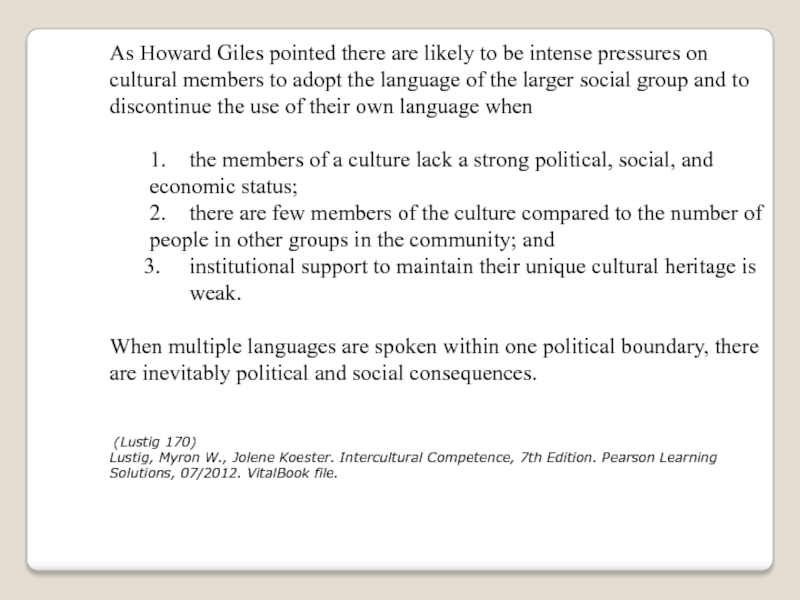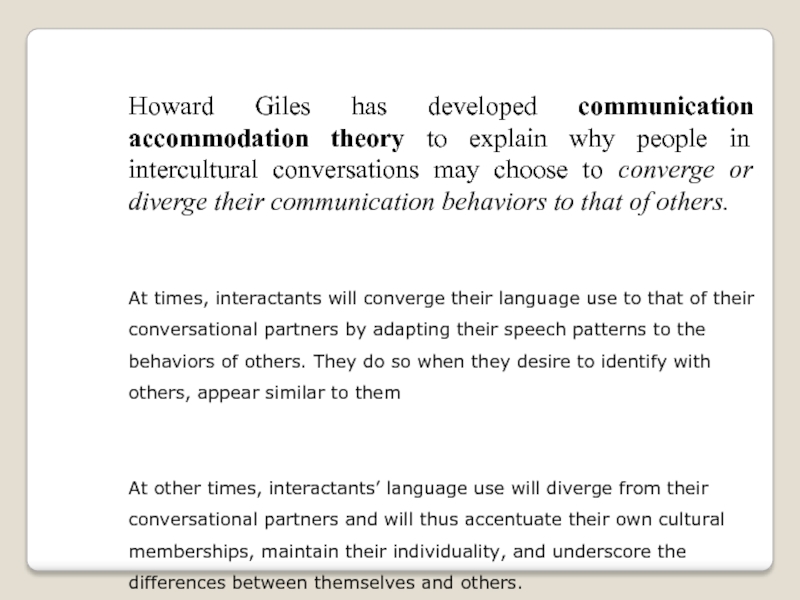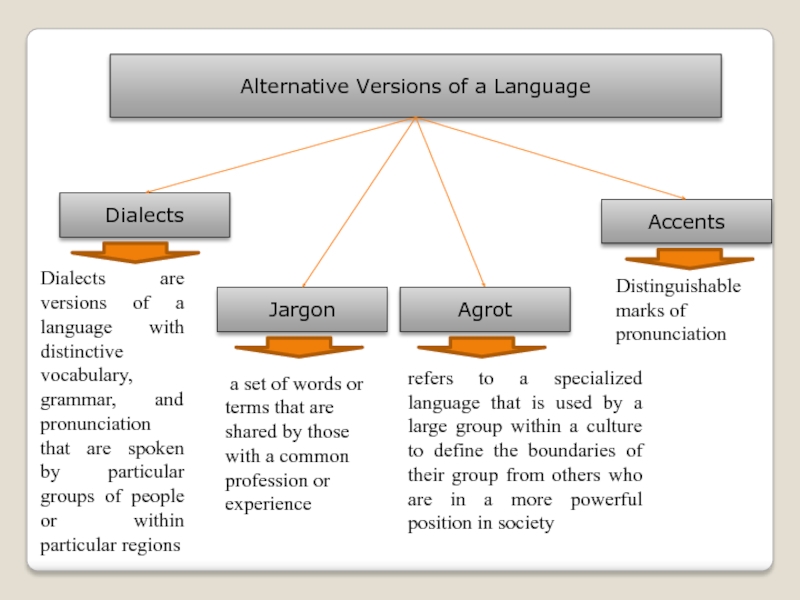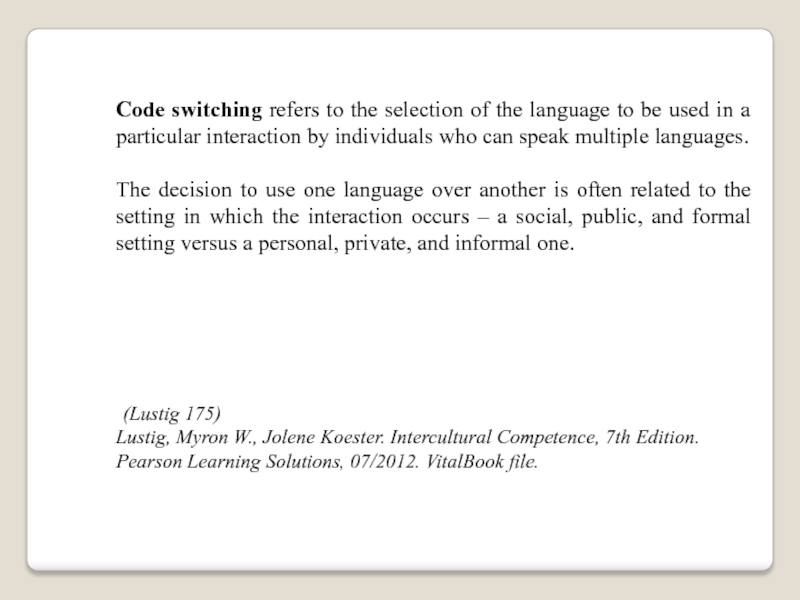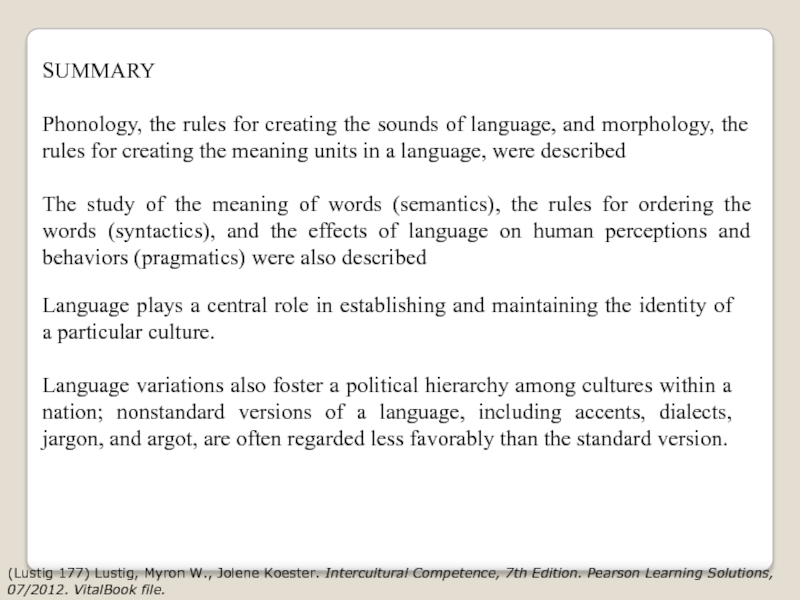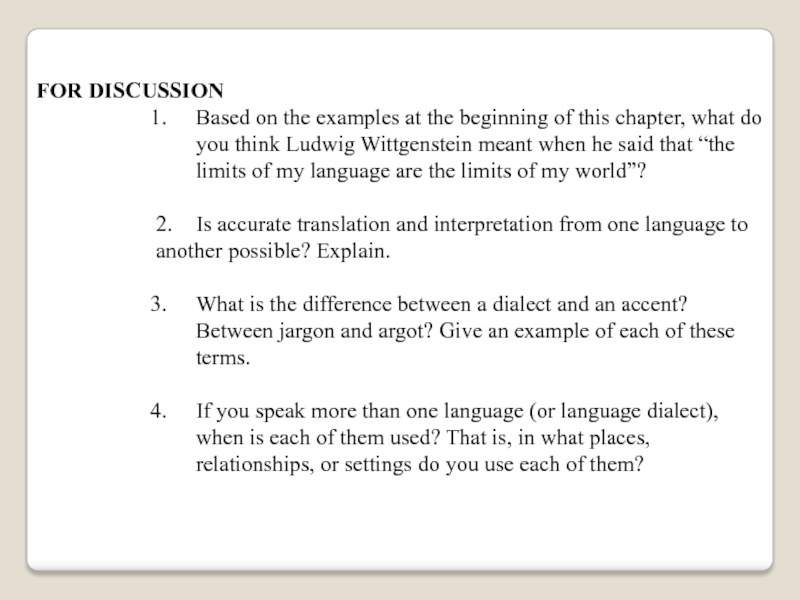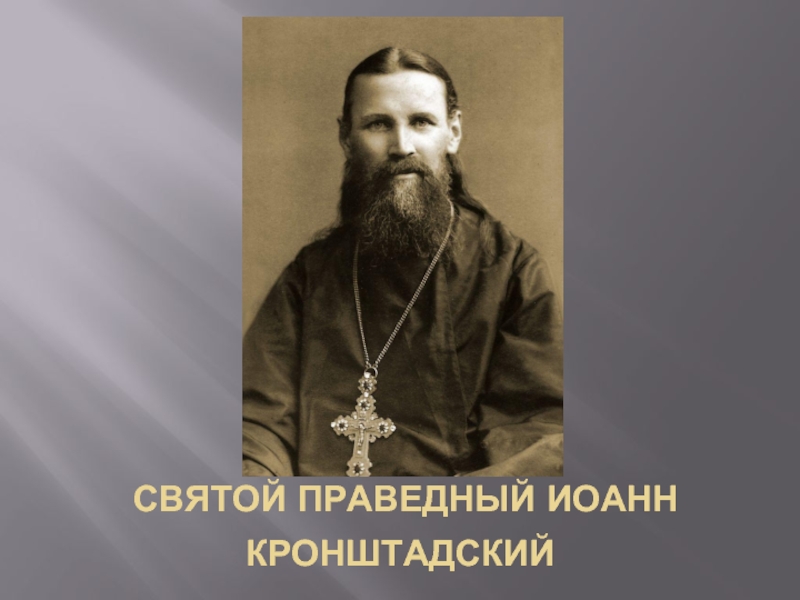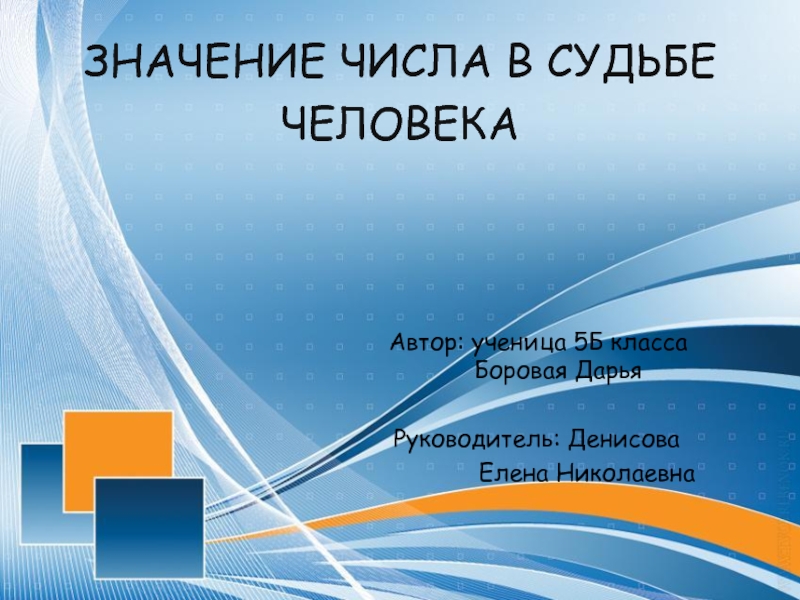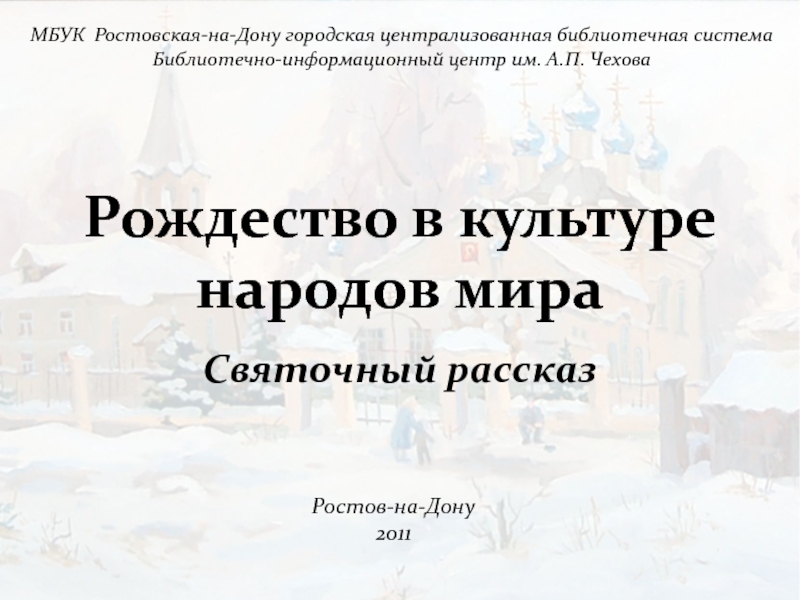- Главная
- Разное
- Дизайн
- Бизнес и предпринимательство
- Аналитика
- Образование
- Развлечения
- Красота и здоровье
- Финансы
- Государство
- Путешествия
- Спорт
- Недвижимость
- Армия
- Графика
- Культурология
- Еда и кулинария
- Лингвистика
- Английский язык
- Астрономия
- Алгебра
- Биология
- География
- Детские презентации
- Информатика
- История
- Литература
- Маркетинг
- Математика
- Медицина
- Менеджмент
- Музыка
- МХК
- Немецкий язык
- ОБЖ
- Обществознание
- Окружающий мир
- Педагогика
- Русский язык
- Технология
- Физика
- Философия
- Химия
- Шаблоны, картинки для презентаций
- Экология
- Экономика
- Юриспруденция
Verbal Intercultural Communication презентация
Содержание
- 1. Verbal Intercultural Communication
- 2. GOALS: To explore the nature of
- 3. Language allows people to understand messages about
- 4. Verbal means “consisting of words.”
- 5. Another critical ingredient of verbal codes is
- 6. (Lustig 155) Lustig, Myron W., Jolene
- 7. The basic sound units of a language
- 8. Phonemes combine to form morphemes, which are
- 9. The study of the meaning of words
- 10. Syntactics – the relationship of words to
- 11. Pragmatics is the effect of language on
- 12. Translation can be defined as the use
- 13. The goal in interpreting from one language
- 14. Types of Equivalence Vocabulary (15) Idiomatic
- 15. Vocabulary Equivalence To establish vocabulary equivalence,
- 16. Idiomatic Equivalence An idiom is an
- 17. The linguistic features allowing to identify objects
- 18. Linguistic relativity is relationships among language, thought,
- 19. Whorf provided detailed descriptions of the Hopi
- 20. Sapir and Whorf’s pointed that
- 21. LANGUAGE AND INTERCULTURAL COMMUNICATION The extent to
- 22. As Howard Giles pointed there are likely
- 23. Howard Giles has developed communication accommodation theory
- 24. Alternative Versions of a Language Dialects
- 25. Code switching refers to the selection of
- 26. SUMMARY Phonology, the rules for creating
- 27. FOR DISCUSSION Based on the examples at
Слайд 2GOALS:
To explore the nature of language;
To understand how verbal codes affect
Слайд 3Language allows people to understand messages about many different topics from
Language allows a person to talk with others, to understand or disagree with them, to make plans, to remember the past, to imagine future events, and to describe and evaluate objects and experiences that exist in some other location.
Language is taught to individuals by others and, thus, is transmitted from generation to generation in much the same way as culture. In other words, language is learned
Charles F. Hockett
(Lustig 154)
Lustig, Myron W., Jolene Koester. Intercultural Competence, 7th Edition. Pearson Learning Solutions, 07/2012. VitalBook file.
DEFINITION OF VERBAL CODES
Слайд 4Verbal means “consisting of words.”
Verbal code is a set of
Verbal codes include both oral (spoken) language and non-oral (written) language.
(Lustig 154)
Lustig, Myron W., Jolene Koester. Intercultural Competence, 7th Edition. Pearson Learning Solutions, 07/2012. VitalBook file.
Spoken verbal codes are used in face-to-face intercultural communication but the written verbal codes play a supporting role in the discussion
The Features of Language
Слайд 5Another critical ingredient of verbal codes is the system of rules
Ingredient of verbal and non-verbal codes is symbols are words, actions, or objects that stand for or represent units of meaning
Слайд 6 (Lustig 155)
Lustig, Myron W., Jolene Koester. Intercultural Competence, 7th Edition.
Rule Systems in Verbal Codes
Five interrelated sets of rules combine to create a verbal code,
or language.
Components/Parts of language
Phonology
Morphology
Semantics
Syntactics
Pragmatics
Слайд 7The basic sound units of a language are called phonemes, and
(Lustig 155)
Lustig, Myron W., Jolene Koester. Intercultural Competence, 7th Edition. Pearson Learning Solutions, 07/2012. VitalBook file.
Languages have different numbers of phonemes.
English, for example, depends on about forty-five phonemes.
The number of phonemes in other languages ranges from as few as fifteen to as many as eighty-five
Слайд 8Phonemes combine to form morphemes, which are the smallest units of
The forty-five English phonemes can be used to generate more than 50 million morphemes
For instance,
the word comfort, whose meaning refers to a state of ease and contentment, contains one morpheme.
But the word comforted contains two morphemes: comfort and -ed.
The latter is a suffix that means that the comforting action or activity happened in the past.
Although all words contain at least one morpheme, some words (such as uncomfortable, which has three morphemes) can contain two or more.
Note that morphemes refer only to meaning units.
Слайд 9The study of the meaning of words is called semantics.
The
(Lustig 156)
Lustig, Myron W., Jolene Koester. Intercultural Competence, 7th Edition. Pearson Learning Solutions, 07/2012. VitalBook file.
Meaning
Connotative
Denotative
the public, objective, and legal meanings of a word (dictionary)
personal, emotionally charged, private, and specific to a particular person
Слайд 10Syntactics – the relationship of words to one another.
Each language has
The sentence “John has, to the store, gone” is an incorrect example of English syntax but an accurate representation of German syntax.
(Lustig 158)
Lustig, Myron W., Jolene Koester. Intercultural Competence, 7th Edition. Pearson Learning Solutions, 07/2012. VitalBook file.
Слайд 11Pragmatics is the effect of language on human perceptions and behaviors.
The study of pragmatics focuses on how language is actually used.
A pragmatic analysis of language goes beyond phonology, morphology, semantics, and syntactics.
It considers how users of a particular language are able to understand the meanings of specific utterances in particular contexts.
(Lustig 158)
Lustig, Myron W., Jolene Koester. Intercultural Competence, 7th Edition. Pearson Learning Solutions, 07/2012. VitalBook file.
Слайд 12Translation can be defined as the use of verbal signs to
Translation usually refers to the transfer of written verbal codes between languages.
Interpretation refers to the oral process of moving from one code to another.
Example 5
(Lustig 160)
Lustig, Myron W., Jolene Koester. Intercultural Competence, 7th Edition. Pearson Learning Solutions, 07/2012. VitalBook file.
Interpretation and Intercultural Communication
Слайд 13The goal in interpreting from one language to another is to
Equivalence refers to a simpler way of describing the goal.
Слайд 14Types of Equivalence
Vocabulary (15)
Idiomatic (16)
Dynamic equivalence offered as one
good translation and interpretation.
(Lustig 160)
Lustig, Myron W., Jolene Koester. Intercultural Competence, 7th Edition. Pearson Learning Solutions, 07/2012. VitalBook file.
Five kinds of equivalence must be considered in moving from one language to another: vocabulary, idiomatic, grammatical–syntactical, experiential, and conceptual equivalence
Experiential
Conceptual
Grammatical-syntactical
Слайд 15Vocabulary Equivalence
To establish vocabulary equivalence, the interpreter seeks a word in
EXAMPLES:
In Nigeria, there is no word for window (opening)
Difference between House/home in English
Слайд 16Idiomatic Equivalence
An idiom is an expression that has a meaning contrary
“It’s raining cats and dogs,”
“There’s no free sandwiches”
Слайд 17The linguistic features allowing to identify objects and experiences which distinguish
To understand the effects of language on intercultural communication, questions such as the following must be explored:
■ How do initial experiences with language shape or influence the way in which a person thinks?
■ Do the categories of a language—its words, grammar, and usage—influence how people think and behave?
More specifically, consider the following question:
■ Does a person growing up in Saudi Arabia, who learns to speak and write Arabic, “see” and “experience” the world differently than does a person who grows up speaking and writing Tagalog in the Philippines?
Слайд 18Linguistic relativity is relationships among language, thought, culture, and intercultural communication
(Lustig 162)
Lustig, Myron W., Jolene Koester. Intercultural Competence, 7th Edition. Pearson Learning Solutions, 07/2012. VitalBook file.
Sapir and Whorf’s major contribution to the study of intercultural communication is that they called attention to the integral relationship among thought, culture, and language.
Variations in vocabulary
Variations in linguistic grammars
Cultural conceptions of time
Showing respect and social hierarchy
Pronouns and Cultural Characteristics
Linguistic Relativity and Intercultural Communication
Слайд 19Whorf provided detailed descriptions of the Hopi language that illustrate how
Hopi do not linguistically refer to time as a fixed point or place but rather as a movement in the stream of life.
The English language, in contrast, refers to time as a specific point that exists on a linear plane divided into past, present, and future
Слайд 20Sapir and Whorf’s pointed that
Language does not determine our ability
However, language shapes and influences our thoughts and behaviors.
The vocabulary of a language reflects what you need to know to cope with the environment and the patterns of your culture.
The semantics and syntactics of language gently nudge you to notice particular kinds of things in your world and to label them in particular ways.
All of these components of language create habitual response patterns to the people, events, and messages that surround you.
(Lustig 168)
Lustig, Myron W., Jolene Koester. Intercultural Competence, 7th Edition. Pearson Learning Solutions, 07/2012. VitalBook file.
Слайд 21LANGUAGE AND INTERCULTURAL COMMUNICATION
The extent to which a culture maintains a
It refers to “the individual’s subjective perception of the status, demographic characteristics, and institutional support of the language community.”
(Lustig 170)
Lustig, Myron W., Jolene Koester. Intercultural Competence, 7th Edition. Pearson Learning Solutions, 07/2012. VitalBook file.
Слайд 22As Howard Giles pointed there are likely to be intense pressures
1. the members of a culture lack a strong political, social, and economic status;
2. there are few members of the culture compared to the number of people in other groups in the community; and
institutional support to maintain their unique cultural heritage is weak.
When multiple languages are spoken within one political boundary, there are inevitably political and social consequences.
(Lustig 170)
Lustig, Myron W., Jolene Koester. Intercultural Competence, 7th Edition. Pearson Learning Solutions, 07/2012. VitalBook file.
Слайд 23Howard Giles has developed communication accommodation theory to explain why people
At times, interactants will converge their language use to that of their conversational partners by adapting their speech patterns to the behaviors of others. They do so when they desire to identify with others, appear similar to them
At other times, interactants’ language use will diverge from their conversational partners and will thus accentuate their own cultural memberships, maintain their individuality, and underscore the differences between themselves and others.
Слайд 24Alternative Versions of a Language
Dialects
Accents
Jargon
Agrot
Dialects are versions
Distinguishable marks of pronunciation
a set of words or terms that are shared by those with a common profession or experience
refers to a specialized language that is used by a large group within a culture to define the boundaries of their group from others who are in a more powerful position in society
Слайд 25Code switching refers to the selection of the language to be
The decision to use one language over another is often related to the setting in which the interaction occurs – a social, public, and formal setting versus a personal, private, and informal one.
(Lustig 175)
Lustig, Myron W., Jolene Koester. Intercultural Competence, 7th Edition. Pearson Learning Solutions, 07/2012. VitalBook file.
Слайд 26SUMMARY
Phonology, the rules for creating the sounds of language, and morphology,
The study of the meaning of words (semantics), the rules for ordering the words (syntactics), and the effects of language on human perceptions and behaviors (pragmatics) were also described
(Lustig 177) Lustig, Myron W., Jolene Koester. Intercultural Competence, 7th Edition. Pearson Learning Solutions, 07/2012. VitalBook file.
Language plays a central role in establishing and maintaining the identity of a particular culture.
Language variations also foster a political hierarchy among cultures within a nation; nonstandard versions of a language, including accents, dialects, jargon, and argot, are often regarded less favorably than the standard version.
Слайд 27FOR DISCUSSION
Based on the examples at the beginning of this chapter,
2. Is accurate translation and interpretation from one language to another possible? Explain.
What is the difference between a dialect and an accent? Between jargon and argot? Give an example of each of these terms.
If you speak more than one language (or language dialect), when is each of them used? That is, in what places, relationships, or settings do you use each of them?

